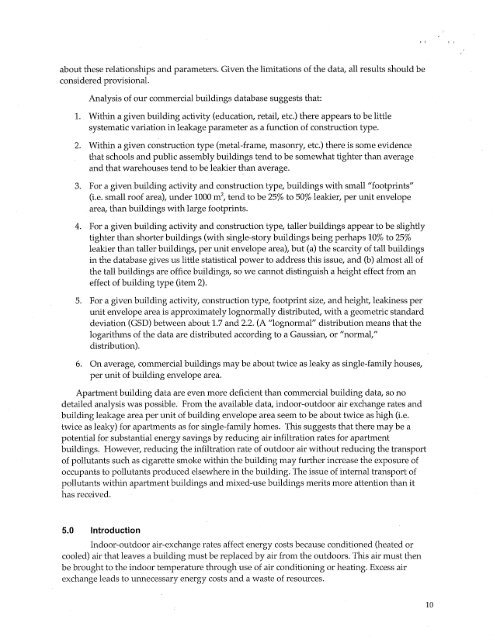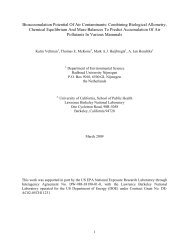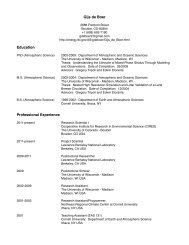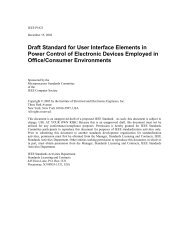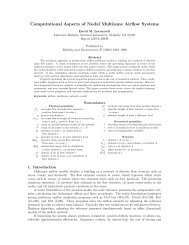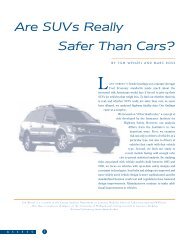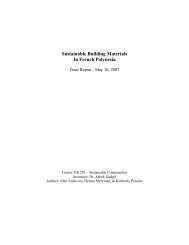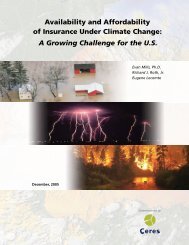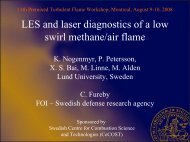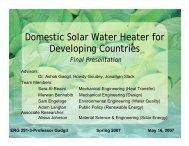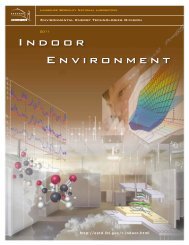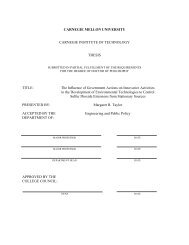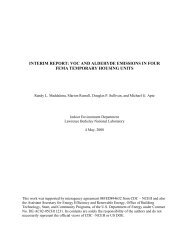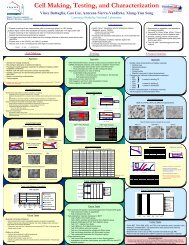indoor-outdoor air leakage of apartments and commercial buildings
indoor-outdoor air leakage of apartments and commercial buildings
indoor-outdoor air leakage of apartments and commercial buildings
Create successful ePaper yourself
Turn your PDF publications into a flip-book with our unique Google optimized e-Paper software.
about these relationships <strong>and</strong> parameters. Given the limitations <strong>of</strong> the data, all results should be<br />
considered provisional.<br />
Analysis <strong>of</strong> our <strong>commercial</strong> <strong>buildings</strong> database suggests that:<br />
1. Within a given building activity (education, retail, etc.) there appears to be little<br />
systematic variation in <strong>leakage</strong> parameter as a function <strong>of</strong> construction type.<br />
2. Within a given construction type (metal-frame, masonry, etc.) there is some evidence<br />
that schools <strong>and</strong> public assembly <strong>buildings</strong> tend to be somewhat tighter than average<br />
<strong>and</strong> that warehouses tend to be leakier than average.<br />
3. For a given building activity <strong>and</strong> construction type, <strong>buildings</strong> with small "footprints"<br />
(i.e. small ro<strong>of</strong> area), under 1000 m 2 , tend to be 25% to 50% leakier, per unit envelope<br />
area, than <strong>buildings</strong> with large footprints.<br />
4. For a given building activity <strong>and</strong> construction type, taller <strong>buildings</strong> appear to be slightly<br />
tighter than shorter <strong>buildings</strong> (with single-story <strong>buildings</strong> being perhaps 10% to 25%<br />
leakier than taller <strong>buildings</strong>, per unit envelope area), but (a) the scarcity <strong>of</strong> tall <strong>buildings</strong><br />
in the database gives us little statistical power to address this issue, <strong>and</strong> (b) almost all <strong>of</strong><br />
the tall <strong>buildings</strong> are <strong>of</strong>fice <strong>buildings</strong>, so we cannot distinguish a height effect from an<br />
effect <strong>of</strong> building type (item 2).<br />
5. For a given building activity, construction type, footprint size, <strong>and</strong> height, leakiness per<br />
unit envelope area is approximately lognormally distributed, with a geometric st<strong>and</strong>ard<br />
deviation (GSD) between about 1.7 <strong>and</strong> 2.2. (A "lognormal" distribution means that the<br />
logarithms <strong>of</strong> the data are distributed according to a Gaussian, or "normal,"<br />
distribution).<br />
6. On average, <strong>commercial</strong> <strong>buildings</strong> may be about twice as leaky as single-family houses,<br />
per unit <strong>of</strong> building envelope area.<br />
Apartment building data are even more deficient than <strong>commercial</strong> building data, so no<br />
detailed analysis was possible. From the available data, <strong>indoor</strong>-<strong>outdoor</strong> <strong>air</strong> exchange rates <strong>and</strong><br />
building <strong>leakage</strong> area per unit <strong>of</strong> building envelope area seem to be about twice as high (i.e.<br />
twice as leaky) for <strong>apartments</strong> as for single-family homes. This suggests that there may be a<br />
potential for substantial energy savings by reducing <strong>air</strong> infiltration rates for apartment<br />
<strong>buildings</strong>. However, reducing the infiltration rate <strong>of</strong> <strong>outdoor</strong> <strong>air</strong> without reducing the transport<br />
<strong>of</strong> pollutants such as cigarette smoke within the building may further increase the exposure <strong>of</strong><br />
occupants to pollutants produced elsewhere in the building. The issue <strong>of</strong> internal transport <strong>of</strong><br />
pollutants within apartment <strong>buildings</strong> <strong>and</strong> mixed-use <strong>buildings</strong> merits more attention than it<br />
has received.<br />
5.0 Introduction<br />
Indoor-<strong>outdoor</strong> <strong>air</strong>-exchange rates affect energy costs because conditioned (heated or<br />
cooled) <strong>air</strong> that leaves a building must be replaced by <strong>air</strong> from the <strong>outdoor</strong>s. This <strong>air</strong> must then<br />
be brought to the <strong>indoor</strong> temperature through use <strong>of</strong> <strong>air</strong> conditioning or heating. Excess <strong>air</strong><br />
exchange leads to unnecessary energy costs <strong>and</strong> a waste <strong>of</strong> resources.<br />
"<br />
10


